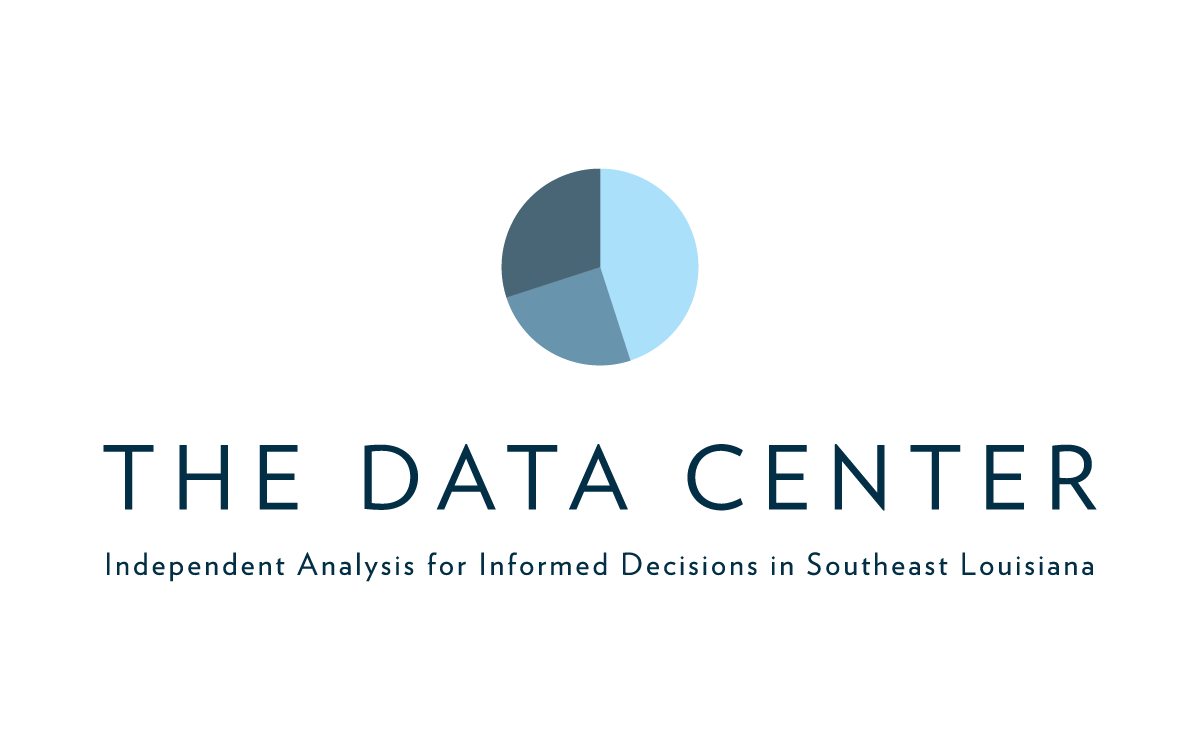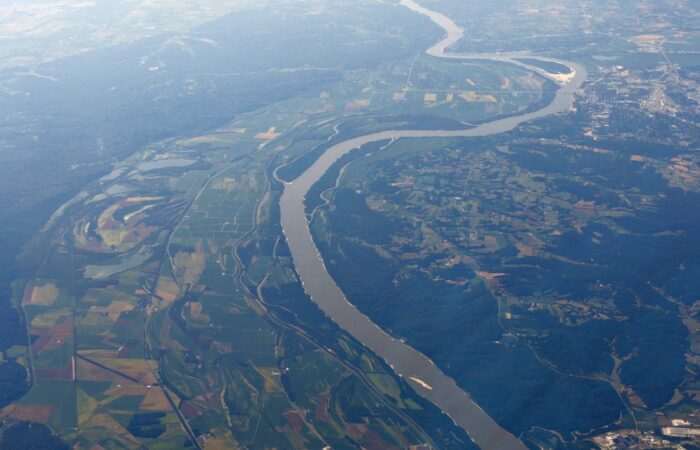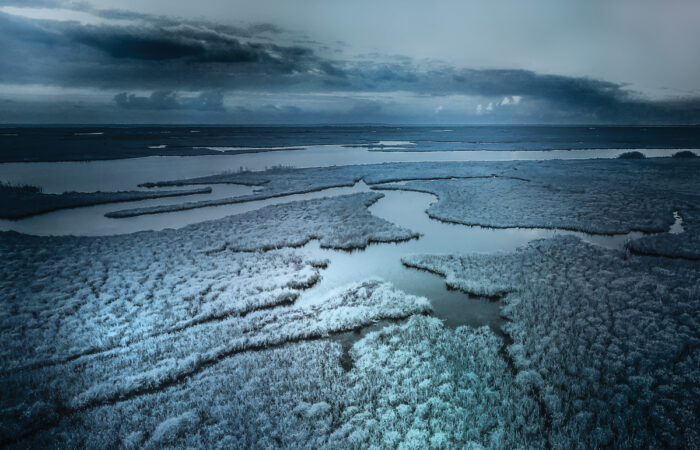
Toward an equitable blue-green economy: Skills in water and green jobs
Published: Apr 05, 2022
At the federal level and in states and cities across the country, leaders are exploring how to connect job creation and equity goals with infrastructure improvement and climate change mitigation. These connections are especially relevant to Southeast Louisiana, where sea-level rise, loss of wetlands, increasing frequency of devastating tropical weather events like Hurricane Ida, and reduced reliance on emissions-intensive industry will shape the region’s future. Without targeted policy and planning, these stressors will disproportionately affect communities with the least financial resources and highest levels of vulnerability. At the same time, these challenges have the potential to reveal inclusive, sustainable pathways to economic growth. Carving out a more resilient future for Southeast Louisiana means confronting long-standing regional challenges around racial equity, environmental justice, and economic diversification.
Based on interviews with 30 people who work locally on these issues, the report, Toward an equitable blue-green economy in Southeast Louisiana, examines the alignment of economic development, environmental adaptation, and equitable inclusion in Southeast Louisiana. It focuses on critical opportunities where environmental investments are being made: mitigating flood risks and upgrading water infrastructure; protecting and restoring the coast; and reducing greenhouse gas emissions. Together, this “blue-green” economy offers the region a pathway to a more economically diverse and equitable future.
This brief highlights key findings on workforce skills for water and green jobs. While important, skills are not the only consideration for building an equitable, inclusive, and innovative sector. A companion post focuses more directly on barriers to an equitable blue-green economy, as well as insights on how to overcome them. For more detailed analysis, as well as a description of data sources and methods, see the full report.
Jobs in the blue-green economy
In Southeast Louisiana, enthusiasm for green economic development is currently associated with two emerging sectors:
- Coastal and water management (“blue” or “water”) industries focus broadly on water infrastructure and flood mitigation, including a range of investments related to coastal protection and restoration. Among the varied jobs involved with large water management projects, some of the largest in terms of employment are engineers who design infrastructure projects and building trades occupations that implement their construction.
- “Green jobs” focus on restoring or enhancing environmental quality, such as reducing pollution and greenhouse gas emissions, building capacity for renewable energy, and conserving healthy ecosystems. These might include jobs such as solar panel installers, recycling workers and coordinators, environmental engineers, and landscape architects. Some green jobs may be generated indirectly as efforts to reduce greenhouse gas emissions, shift to renewable energy, and create sustainable infrastructure reverberate throughout the economy. These might include construction and building inspectors, commercial and industrial designers, and transportation managers.
To be clear, these categories of green and blue jobs are not mutually exclusive. For example, wetland restoration occupations, such as hydrologists, machine operators, planners, and geographic information systems technicians, are all categorized as both “blue” and “green.” As rough approximations, both encompass a wide range of jobs in different industries. The common thread is that blue-green jobs are engaged in the work of making the region’s environment, economy, and communities more resilient and sustainable.
As such, the “blue-green economy” rightly calls to mind jobs in environmental sciences, infrastructure construction and maintenance, renewable energy and other technologies, and design and engineering. The data presented below summarizes characteristics of these jobs. However, many professionals working in the blue-green economy do not necessarily see it in such narrow terms but rather as a more encompassing project of supporting communities as they adapt to environmental and economic changes.
In Southeast Louisiana, numerous policymakers, economic development and environmental organizations, and other stakeholders have recognized the potential for significant job creation in addressing Louisiana’s environmental challenges. This is reflected in Louisiana’s Coastal Master Plan, a 50-year plan to protect and restore the coast, approved by the state legislature since the 2000s and fueled by an infusion of funding following the 2010 Deepwater Horizon spill. Recently, the Governor’s Climate Initiatives Task Force and Infrastructure Investment and Jobs Act have also highlighted the job creation potential of investments in clean energy and environmental restoration, mitigation, and adaptation.
Yet, many questions remain around how local workers and businesses can access the blue-green economy. Below we examine the characteristics of green and water jobs through the lens of skills. The aforementioned companion brief examines other considerations for an equitable blue-green economy.
How an environmental transition can alter the demand for skills
New skills may be required to work in clean energy, coastal restoration, or water management. These dynamics should translate into increased demand in existing jobs, some with enhanced skills, as well as some entirely new kinds of jobs. For example, according to the Department of Labor, the impact of green economy activities and technologies could alter demand for specific skills in the following ways:
- Existing skills with increased demand. A traditional skillset (e.g., building and construction) might see increased demand (e.g., installing residential solar panels). While the number of openings in certain occupations may change, their specific tasks and skills might remain largely unchanged.
- Green enhanced skills. Workers in traditional occupations (e.g., engineering) might need to acquire new skills specific to green projects to keep up with changing demand (e.g., design for green infrastructure).
- New or emerging skills. Emerging green occupations might involve entirely new, or new combinations, of tasks and skills., These new types of occupations and the skills they will require are less well understood so far, and their prevalence may vary across regional labor markets. Examples of emerging jobs include climate change analyst, instrument operator for emissions measurements, environmental restoration planner, brownfield redevelopment site manager, and carbon sequestration system installer.
In many cases, increased demand for green jobs is expected to lean heavily on traditional skillsets closely related to a significant portion of the existing regional workforce. In fact, previous research suggests that very few green jobs are entirely new. Instead, most resemble existing jobs, sometimes with new tasks that require upgraded skills.,,, These enhanced green skills might pertain, for example, to construction with low-carbon materials or to the integration of plants, soils, and green technologies into design.
Even short of drastic growth of new and emerging green occupations, changing skill demand could affect a vast number of jobs. Data from the U.S. Department of Labor suggests that, in Southeast Louisiana, jobs with existing skills and increased demand from green economy activities (without any significant altering of the work or requirements) comprised over 8 percent of total employment in 2019. Green jobs likely to require enhanced skills (for which the essential elements of the occupation remain the same) made up 7 percent of total employment.
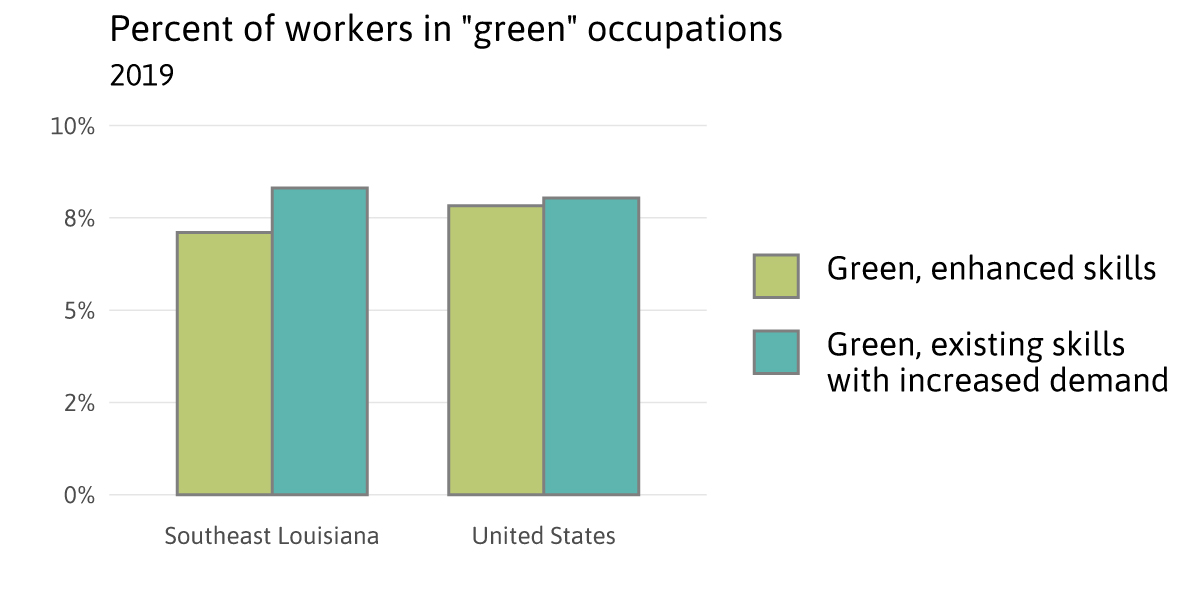 Source: The Data Center analysis of data from EMSI and O*net. Note that “new and emerging” green occupations are not well-captured in local data and therefore excluded from this chart.
Source: The Data Center analysis of data from EMSI and O*net. Note that “new and emerging” green occupations are not well-captured in local data and therefore excluded from this chart.
In short, the blue-green economy is more likely to require incremental shifts in knowledge or qualifications than a complete retraining of the regional workforce. However, these shifts still could have uneven effects on workers of differing skill, education, and experience backgrounds.
Skills in green and water jobs
Water and green jobs are not easy to measure. Here’s how we do it.
- Water management and coastal (or “blue”) jobs: the group of jobs that encompasses the heavy construction, design, engineering, and specialized services most closely related to procurement activities for coastal projects and urban water infrastructure. See “The Coastal Index” and a related 2019 brief for more details. These jobs are further divided into: “water management production and project implementation” occupations and “water management planning, design, and services” occupations —for the most part, “blue collar” versus “white collar” jobs, though these distinctions are not always clear-cut.
- Green jobs: the broad set of emerging occupations that will experience increased demand or new skill requirements due to climate change mitigation or enhancing environmental quality. The green occupations definition we use comes from the US Department of Labor, so the set of occupations are not directly tailored to the composition of Louisiana’s green economy. In some of the analysis, these jobs are further divided into “green enhanced skills” and “green increased demand” – capturing whether the green jobs are expected to require new skills or not.
To examine the characteristics of water and green occupations, we break them out into sub-categories (see the box for details). While pay within these categories varies, the “typical” occupational wage in each tends to pay more than typical jobs in region. Likewise, previous nationwide analyses of clean energy and water jobs tend to find that they pay relatively well, including for workers with less formal education.,
| Distribution of typical occupational hourly wages by occupation group, Southeast Louisiana | ||||
|---|---|---|---|---|
| percentile | ||||
| 25 | 50 | 75 | ||
| All industries | $11.68 | $18.02 | $25.73 | |
| Water | Production and project implementation | $15.99 | $21.52 | $26.80 |
| Planning, design, and services | $20.92 | $28.50 | $40.27 | |
| Green | Increased demand | $12.97 | $18.39 | $29.66 |
| Enhanced skills | $18.37 | $23.80 | $46.29 | |
Source: The Data Center analysis of data from EMSI and O*net.
Compared with the entire regional workforce, green occupations are more likely to be accessible with a high school diploma and less likely to require an advanced degree. Many of the green jobs that will see increased demand but little change in skill requirements do not require a college degree. The types of green jobs using new enhanced skills will more often require postsecondary training or a college degree. Most water jobs in the production and implementation of water projects will require only a high school education while water jobs in fields like design, engineering, scientific research, and planning are more likely to require a Bachelor’s degree or an Associate’s degree.
Previous national reports on green and water jobs have found that these jobs are more likely to require on-the-job training and applied learning than jobs in the economy as a whole., In Southeast Louisiana, green jobs that require enhanced skills, as well as production and implementation water jobs, are more likely to include longer term on-the-job training. Interview participants in the design and engineering fields stressed the importance of learning on the job, especially given that blue-green approaches are currently emerging through practice and not yet codified or necessarily learned through their formal education.
Summarizing specific skills associated with green jobs and water jobs helps to illustrate the types of jobs involved—as well as the potential for skill transfer—within the green-blue economy and across the entire economy. The following graphic uses information from the US Department of Labor (O*net) to report the average importance of each skill for green jobs and water jobs, relative to all jobs in the economy.
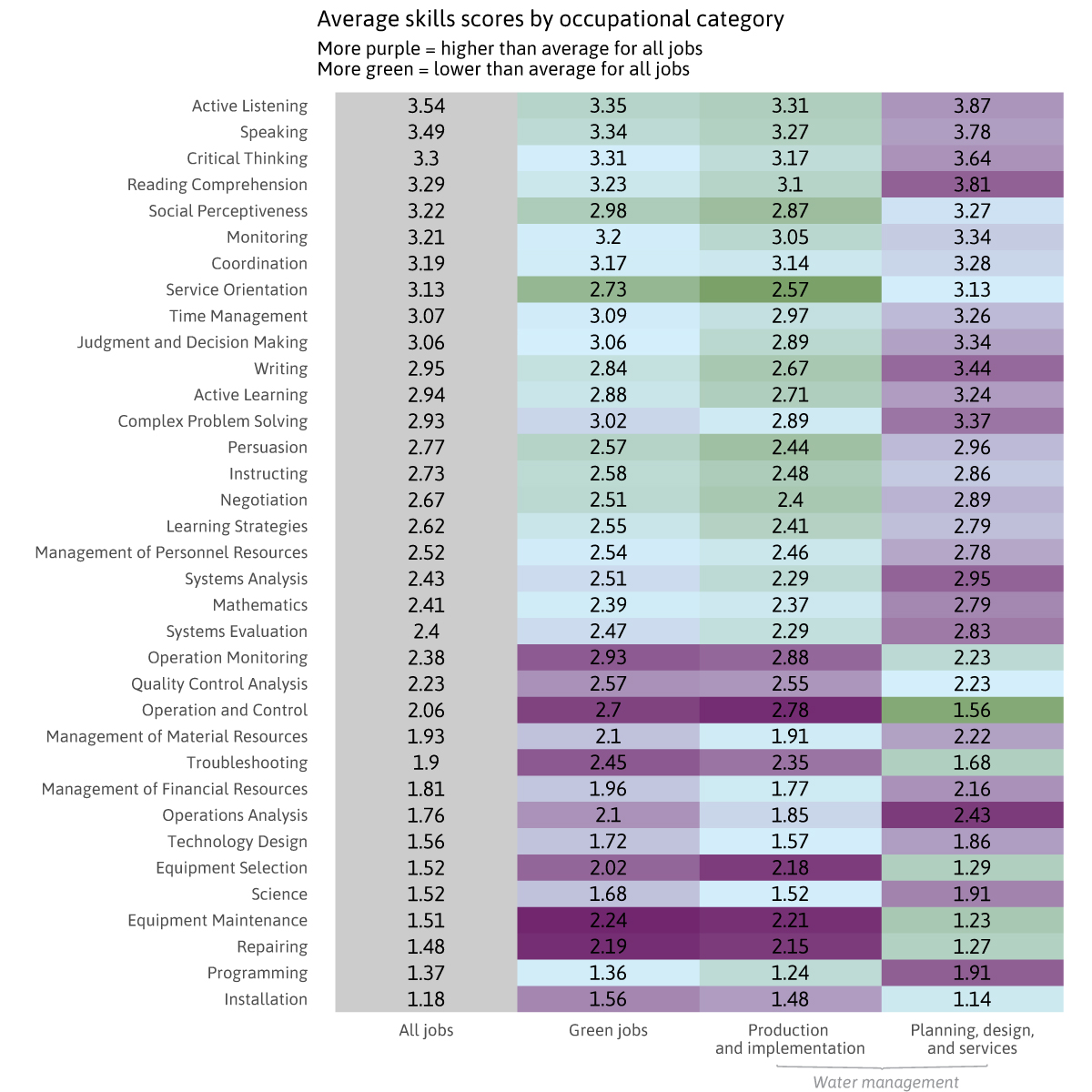 Source: The Data Center analysis of data from EMSI and O*net.
Source: The Data Center analysis of data from EMSI and O*net.
Above-average scores (purple) indicate skills and knowledge requirements more important for green and water jobs than for the average for all occupations in the region. Both green jobs and water jobs in production and project implementation place above-average value on technical skills like operation monitoring and control, troubleshooting, and equipment selection, installation, maintenance, and repair. These skills correspond with mechanical and building and construction tasks. In contrast, water jobs in planning, design, and services fields, which include many science and engineering jobs that require a four-year degree, involve a broader set of skills at levels higher than in the regional economy overall, including more basic, social, and problem-solving skills. Taken together, the region’s existing green and water jobs cover a spectrum of skills that are accessible to workers with a range of skill backgrounds, create opportunities for skill transfer, and provide exposure to a range of different types of careers in related professional settings.
While the interview participants provide nuance directly from the perspective of people working in the field, they disagreed on whether Southeast Louisiana’s workforce already has the skills and knowledge necessary to transition into water and green jobs. For example, some who work in coastal areas see ample green transition opportunities for local workers, given the region’s history with oil and gas employment.
“An electrician working on an oil rig is still doing electricity, whether he’s working on an oil rig or if he’s doing electrical work on a wind turbine. We have engineers that could do restoration, or they could design an LNG [Liquified Natural Gas] facility. A dredge operator might be a captain on a dredge boat, or he might be a captain on a supply vessel to an oil platform. A welder might weld a dredge pipe, or he might build ships.” (public)
“Because the oil industry has been so prevalent in this area… we have people with a skillset that could transfer to renewable energy, I think, fairly easily. There are machine shops. There are people who know how to install very large pipes. I think that a pipe that moves oil is not so much different than a pipe that moves sediment. Our people can build [turbines]. We know how to weld and cut out metal pieces and put it all together.” (nonprofit)
Yet, two with experience on green infrastructure and stormwater management projects suggested that green approaches still need to be cultivated in local design and construction industries, highlighting the distinct expertise required for traditional and emerging blue-green approaches.
“There’s been a lot of talk with the bond money, the settlement, FEMA dollars, etcetera…There may be contractors that advocate, like, we are experts at this, or we do this. But in the industry, all of this is fairly new—a lot of the projects, designs, or products that’s being put out there or just being constructed. I would say we haven’t had enough time to even see the benefits or conditions that derive from those new designs or products.” (private)
“[People can’t be] pretending they know what they talk about with green infrastructure. This is a specialized field, even down to the plants that you’re planting…you can’t put something there and say that it’s a native plant, when there’s a whole organization of people nationally and locally who know, who can tell you this is not a native plant.” (nonprofit)
Many of the interview participants emphasized that the complex processes of decarbonizing the economy, reducing flood risk, conserving land, and easing community transition rely upon (and build) a broad set of knowledge, especially when incorporating equity goals into these processes. One participant with a neighborhood-level, workforce development perspective remarked, “When we start to think about our young folks and the career opportunities that [water] presents, there is room for everyone. There is a role for everyone to partake in our climate.” Given all that this work covers, skills important to the blue-green economy highlighted by the interviewees fall into four broad categories: baseline soft skills, social and cultural practice skills, applied skills for science and technology, and experiential water and green skills.
| Baseline soft skills | Communication, collaboration, writing, listening |
|---|---|
| Social and cultural practice skills | Language interpretation (mentioned: Spanish, Vietnamese, Khmer, Cajun French), mental health services and social work, management of housing and finance, job services, community engagement and organizing, law, planning, arts, environmental history and philosophy, documentation of ecological and cultural change, experience in anti-racism work |
| Applied skills for science, engineering, and technology | Decisionmaking, measurement, spatial, hands-on problem solving at project sites, building, business, marketing, management, grant writing procedures (especially federal grants), and work experience in holistic approaches to water |
| Experiential water and green skills | Outdoor inclined or experienced, green thumb, farming, boating, traditional and local ecological knowledge, including knowledge of native plants |
Conclusion
Decisionmakers in government, private industry, and the civic sector have increasingly embraced the blue-green economy as integral to the future of Southeast Louisiana. Indeed, the blue-green economy can generate good-paying jobs, attainable to workers with a range of skill backgrounds. In many cases, the region’s existing workforce may not need wholesale re-skilling to access these jobs. Rather, facilitating transition of local workers into these jobs requires building a broad base of career pathways, stackable skills, and varied entry points into job opportunities.
However, water and green jobs are not silver bullets to address the motors of systemic inequity in the economy. While many water and green jobs pay well even without requiring a four-year degree, interview participants raised employment standards and security as a source of uncertainty worth monitoring as these emerging sectors develop. They also noted inequitable access to construction, engineering and design fields, and other key occupations in the blue-green economy. Ensuring that everyone can contribute their skills and knowledge—through formal employment and/or democratic participation in transition planning—is key to building a stronger and more inclusive economy and to the region’s ability to mitigate and adapt to climate change and flooding. The stakes could not be higher. A companion brief takes up this issue, pointing out barriers to an equitable blue-green economy, as well as insights from inside the field on how to overcome them.
Footnotes and Sources
Hess, David and Magdalena Sudibjo. “Supporting regional cleantech sectors in North America.” Sustainability: Science, Practice and Policy 14 no. 1 (2018): 22-30.
www.onetcenter.org/dictionary/22.0/excel/green_occupations.html
Hess, David. Good Green Jobs in a Global Economy: Making and Keeping New Industries in the United States. Cambridge, MA: The MIT Press, 2012.
Pollin, Robert. Greening the Global Economy. Cambridge, MA: The MIT Press, 2015.
Kohler, J. et al. “An agenda for sustainability transitions research: State of the art and future directions.” Environmental Innovation and Societal Transitions 31 (2019): 1-32.
Bowen, Alex, Kuralbayeva, Karlygash, and Eileen Tipoe. “Characterizing green employment: The impacts of ‘greening’ on workforce composition.” Energy Economics 72 (2018): 263-275.
9 International Labor Organization (ILO). “Skills for Green Jobs: A Global View.” (October 2011) https://www.ilo.org/global/publications/ilo-bookstore/order-online/books/WCMS_159585/lang–en/index.htm
For example, an analysis of job creation through climate mitigation programs in California found that two-thirds of green jobs were in traditional building and construction occupations, while only 2% were in new specialized occupations (Zabin et al. 2020)
Bowen, Alex, Kuralbayeva, Karlygash, and Eileen Tipoe. “Characterizing green employment: The impacts of ‘greening’ on workforce composition.” Energy Economics 72 (2018): 263-275
Dierdorff, Erich et al. “Greening of the World of Work: Implications for ONET®-SOC and New and Emerging Occupations.” Prepared for U.S. Department of Labor, submitted by The National Center for ONET Development (February 2009) citeseerx.ist.psu.edu/viewdoc/download?doi=10.1.1.551.6166&rep=rep1&type=pdf#:~:text=Green%20enhanced%20skills%20occupations%20include,green%20economy%20activities%20and%20technologies.
Many of the analyses below use estimates of the occupational employment within these industries as a basis for comparing the jobs employed by these industries.
Unlike the coastal and water management definition, this definition for green jobs is not based on occupational employment within a given industry.
While the relevance of these skills may vary across workplaces and sectors within the blue-green economy, interview participants from across firms, public agencies, and nonprofit and community groups spoke to all four categories.
